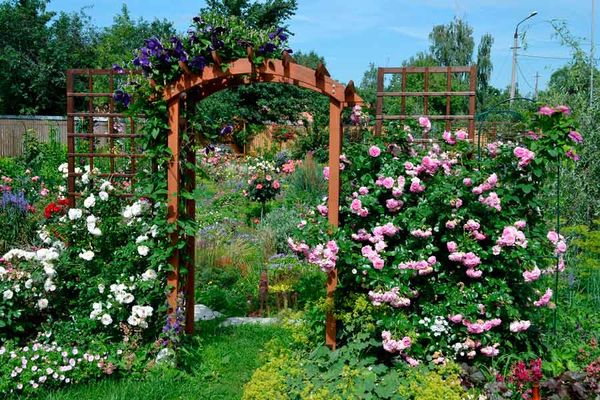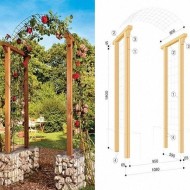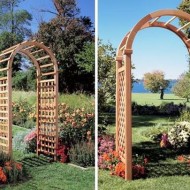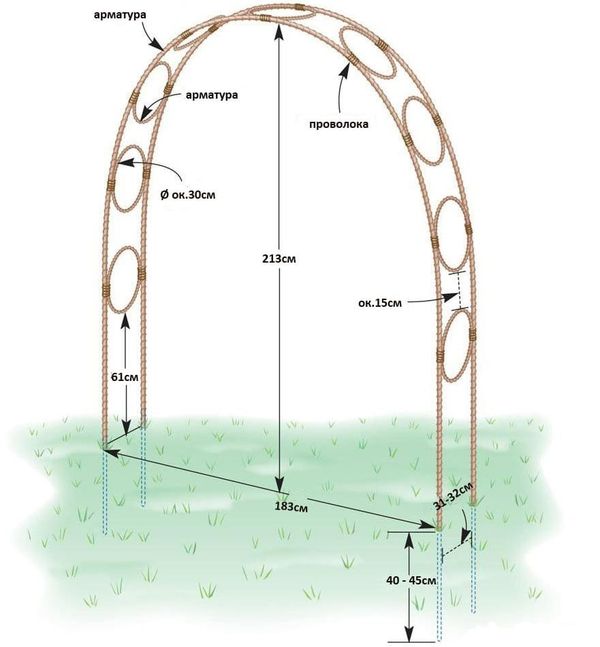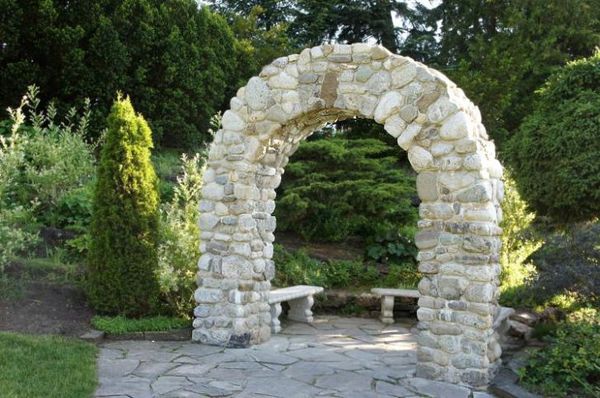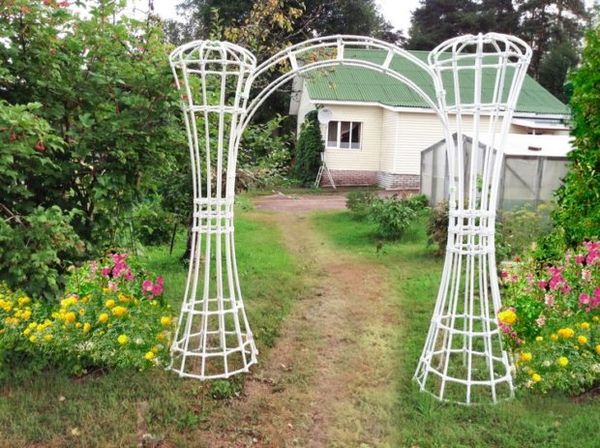Garden arch: how to build an exquisite decoration with your own hands
Content
Arches in landscape design
Being simple in design, arches are capable of performing many functions:
- frame decorative paths;
- symbolize the entrance to the territory;
- delineate different park areas;
- turn into separate decorations for the recreation area.
By arranging several arches one after another and decorating them with plants and light garlands, it is possible to build a kind of shady gallery, and the evening twilight will give it a halo of mystery.
Even in suburban areas, the arched structure has to be in place. However, during construction, certain requirements must be observed:
- The material from which the structure is made must be durable, capable of withstanding bad weather and temperature fluctuations.
- The design is made even and smooth, without protrusions and protruding sharp parts. The supports are reliably dug into the ground.
- The frame is given an aesthetic appearance so that even without vegetation entwining it (for example, in winter), it does not seem ugly.
- Dimensions do not imply bulkiness. A large arch has excessive windage, with a squall wind, the structure is capable of collapsing.
- The height of the structure should be sufficient to allow the tallest family member to pass, and the width should be clear for a wheelchair, garden equipment, etc.
Experts recommend adhering to the following sizes when building an arch in small summer cottages:
- height - from 2 to 3 m;
- width - 1.5 m;
- depth - depending on the type of vegetation on it: for small flowering, 50 cm is enough, for fruitful and large ones - over 70 cm.
Video "Construction of a garden arch-pergola"
From this video you will learn how to build a garden arch-pergola with your own hands.
Different styles
Garden arches differ in several ways. You should choose the right type for your site according to the following criteria:
- Material used in construction. Wood, metal, natural stone are used. There are also combined options.
- Frame shape. In addition to traditional arched structures, there are also: pergolas - the connection of similar modules into a single volumetric structure; trellises - vertical gratings; trellis - connection of several lattice structures; more complex options.
- Location. The decorative structure for the garden is made: single in the form of an isolated arch; combine several modules into a gallery; stretched with trellises into the semblance of a wall separating one part of the garden from another; collected in a closed structure in the manner of a gazebo.
What to build from
There are no strict restrictions on the use of certain building materials. Often, the choice is determined only by the need to harmoniously fit the future arch into the garden landscape.
Suitable for the construction of a structure:
- wood;
- metal;
- plastic;
- vine;
- a rock;
- brick.
During construction, different materials can be combined.
It should be borne in mind that a construction of stones or bricks rarely serves only as a support for climbing plants. By themselves, such arches are independent details of the garden landscape. However, any material endows the structure with characteristic features inherent only to it.
Wooden
Most often, symmetrical pergolas are erected from this material. For construction you will need:
- an even number of wooden posts with a section of 7.5x7.5 or 10x10 cm, which in pairs form a structure stretching along the path;
- the corresponding number of cross beams and crossbars - edged boards with a section of 2x20 cm are suitable.
The erection begins with the installation of the pillars:
- Dig the required number of holes about a meter deep (it all depends on the quality of the soil on the site).
- Sand cushions are built in the pits, rubble is added.
- Support pillars are installed strictly vertically, which are then concreted.
- The columns arranged in two rows are fastened from above with crossbeams, then in pairs with transverse beams.
- The formed structure is primed, then painted with special compounds that protect the surface from decay.
Part of the wood that will be in the ground is also pretreated with anti-rotting agents: coated with molten bitumen, wrapped with roofing material. The rest of the wooden parts are treated with antiseptics.
Although wooden structures are not as reliable as metal ones, they fit harmoniously into the vegetation landscape of the country house.
Metal
The simplest model of an arch can be made with your own hands from the following materials:
- pairs of reinforcing rods bent into an arc with a cross section of 10 cm or more;
- metal bars of a smaller diameter - connecting jumpers.
The manufacturing process consists of several steps:
- With the help of a pipe bender or otherwise, thick metal rods are bent, giving them an arc shape. Make no mistake with the length of the workpiece - after digging into the ground, the arch should be two or more meters high.
- We deepen each arch into the ground to a depth of 40 cm.
- We fasten the arcs together with horizontal metal bridges. It is better to weld them in half-meter increments around the entire perimeter. Instead of straight bridges, metal rings bent into an arc can be used.
- To protect it from rust, the metal is primed and then painted with oil paints.
The result is a robust arched structure. By increasing the number of arches, it is easy to build a small arched gallery.
Instead of welding, connecting straps can be attached with wire. It will turn out not very aesthetically pleasing, but over time, all the flaws will hide under the plants entangling the structure.
If bending of the reinforcement is impossible, metal rods can simply be dug vertically into the ground, connecting them on top with straight jumpers. The arch will come out not curved, but U-shaped, but the design will still turn out to be reliable and practical.
Stone
The creation of such a structure will require the skill of brick or masonry. A beginner is unlikely to be able to build a stone or brick arched structure without involving an experienced craftsman. Such compositions are suitable only for large garden plots, on small areas they look too pompous and completely out of place.
For construction use:
- fake diamond;
- cobblestones of similar shape and size;
- brick for cladding.
If the goal is achieved, a composition will appear in the country house, which will serve as a decoration for the entire site. The arch does not need to be decorated with flowers or covered with climbing plants, but it is appropriate to organize a full-fledged recreation area near it:
- break a flower bed;
- install garden benches;
- mount spotlights to illuminate a massive structure at dusk.
The area adjacent to the arch is covered with a floor covering in the form of paving slabs or stone blocks.
From plastic pipes
For originality, the arch can be shaped like a house with a gable "roof". The manufacturing process is as follows:
- Four polypropylene pipes are vertically dug into the ground to a depth of 30–40 cm - in pairs, with a step of up to half a meter on either side of the track.
- Above, from scraps of pipes assembled into rectangular frames, a gable "roof" frame is constructed.
- Wooden slats or small-section plastic pipes are used as bridges between the posts.
- The lathing on the "roof" is made of the same details.
- It can be connected with horizontal jumpers or in the form of crossing parts.
- It is advisable to varnish the finished structure.
Such a structure is easy to repair in the event of a breakdown, it is also easy to dig, move and install in another place. Remember that plastic is a fragile material, it cracks in the cold, so it is advisable to hide the structure with the onset of cold weather.
What plants to plant
While some arches in themselves can be considered a work of art, most of these structures in the country are a frame for climbing plants. Most often planted for this purpose:
- Grape. Decorative varieties will allow the owners to feast on sweet berries. Different varieties have beautiful foliage and shade.
- Ivy. It grows for a long time, but it will decorate the arch all year round, since it is a frost-resistant and evergreen plant.
- Climbing rose. The arch in pink, white or red colors, planted at different levels, looks very impressive.
The construction of a garden arched structure is a simple process, even a layman can cope with it.
But as a result, an original and useful decorative adornment will appear in the country house, attracting attention and setting you up for a long-awaited rest.

